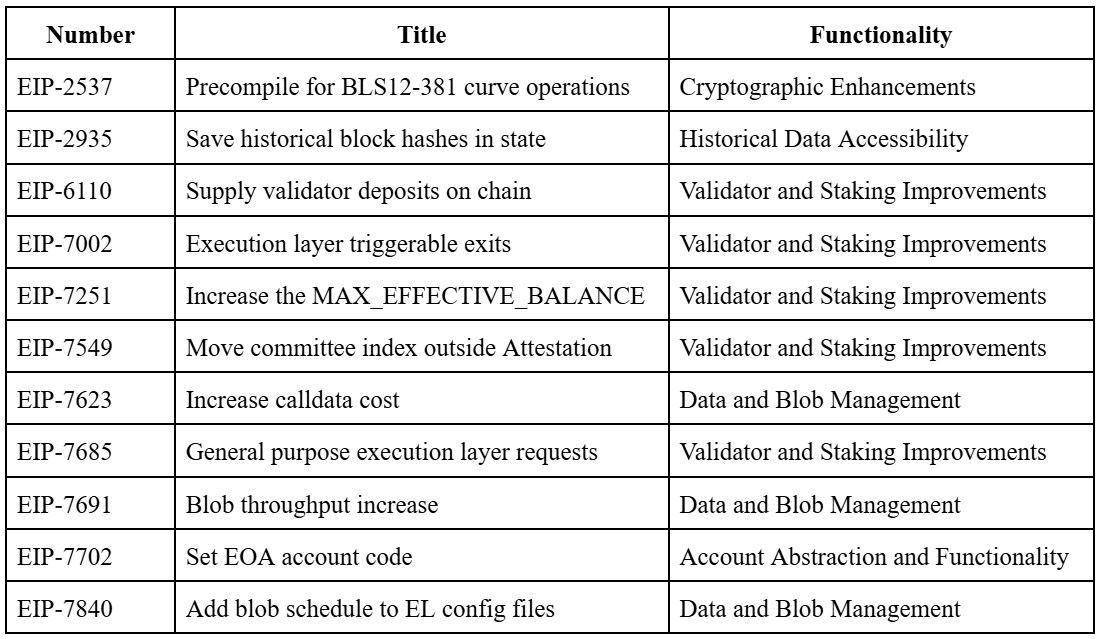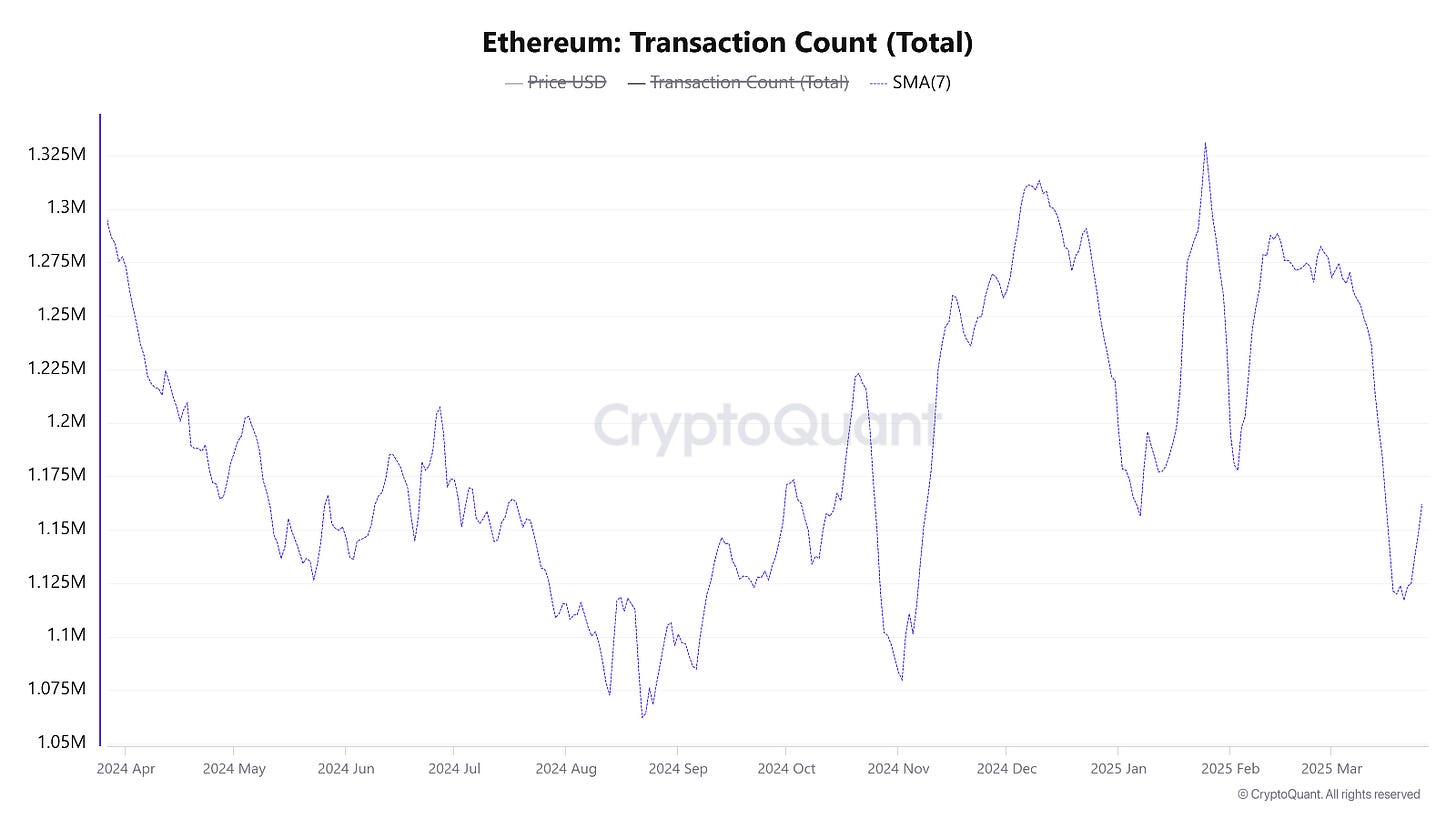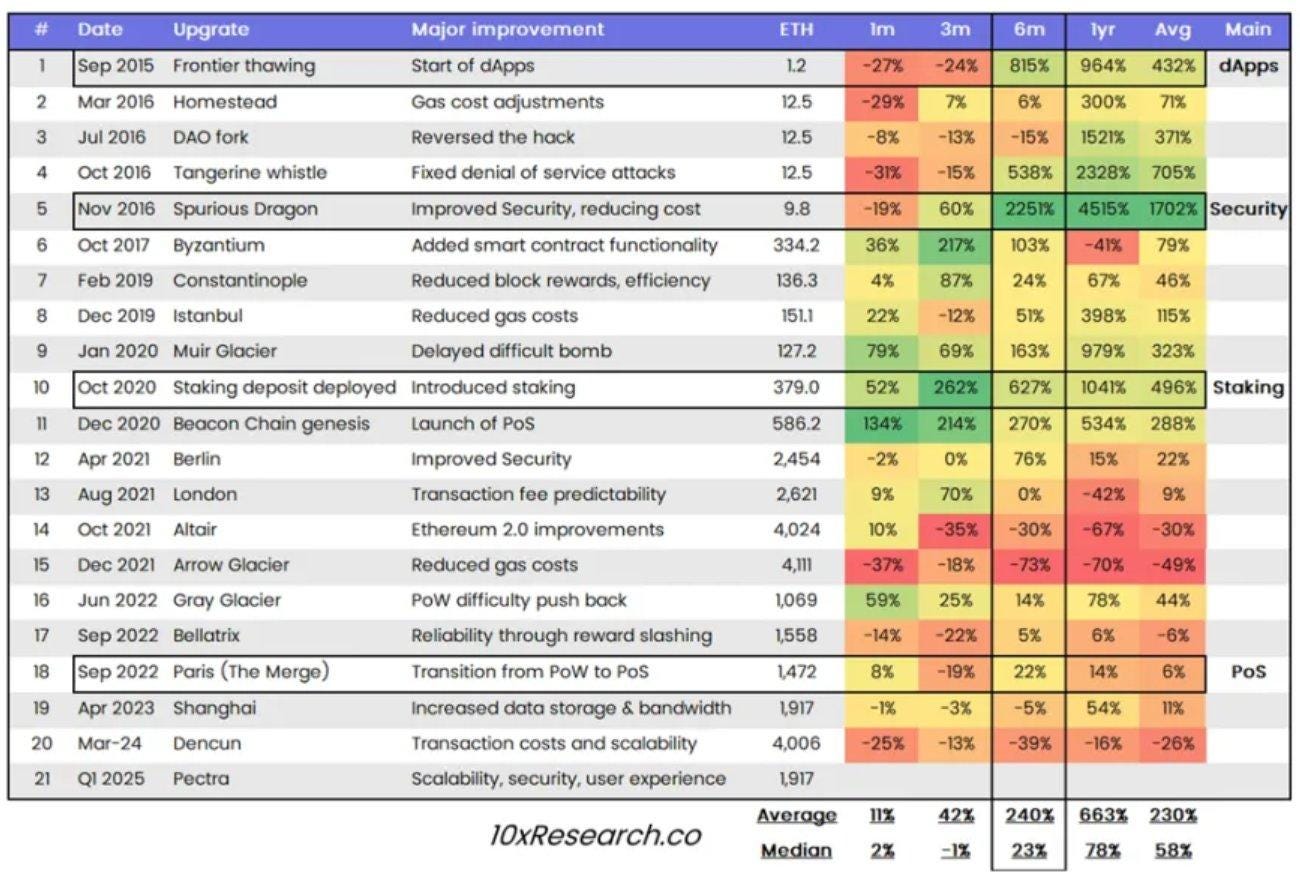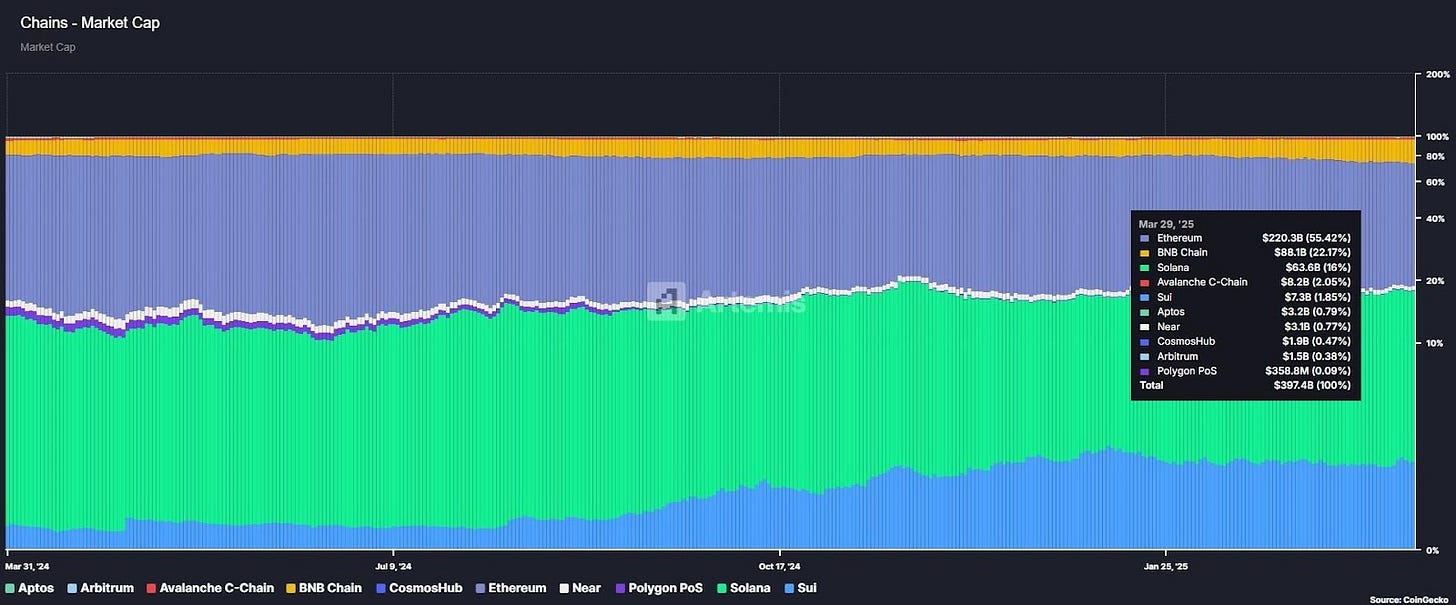Ethereum’s Pectra Upgrade: A Milestone or Just Another Headline?
Disclaimer: The content presented in this article, along with others, is based on opinions developed by the analysts at Dewhales and does not constitute sponsored content. At Dewhales, we firmly adhere to a transparency-first philosophy, making our wallets openly available to the public through our website or DeBank, and our articles serve as vehicles for self-expression, education, and contribution to the ecosystem.
Dewhales Capital does not provide investment advisory services to the public. Any information should not be taken as investment, accounting, tax or legal advice or as a recommendation to purchase, sell or hold or to pursue any investment style or strategy. The accuracy and appropriateness of the information is not guaranteed by Dewhales Capital.
1. Introduction
2. What exactly is the Pectra hard fork and what are its impacts?
3. Challenges and concerns
4. The potential impact of Pectra on Ethereum’s network and ecosystem
5. The potential impact of Pectra on Ethereum’s price
6. What’s the next step for Ethereum?
7. References
1. Introduction
Ethereum’s history of upgrades has followed a structured and deliberate approach, with each update addressing specific technical challenges while also preparing for future demands. From early improvements like Byzantium and Constantinople to the game-changing transition of The Merge, the network has continually evolved to enhance its capabilities and meet market demands. The upcoming Pectra upgrade (EIP-7600) is the latest step in this ongoing evolution, incorporating 11 Ethereum Improvement Proposals (EIPs) that tackle various aspects of the network’s efficiency and functionality.
Building on the foundation of previous upgrades, i.e. The Merge, Shanghai-Capella (Shapella), and Dencun, Pectra aims to eliminate remaining bottlenecks and pave the way for further advancements. In a nutshell, here is how each of previous upgrades served Ethereum:
The Merge (September 2022): Marked Ethereum’s shift from PoW to PoS, drastically cutting energy consumption and introducing staking as the new consensus mechanism.
Shanghai-Capella (April 2023): Also called Shapella, this upgrade enabled stakers to withdraw their locked ETH, improving liquidity within the Ethereum ecosystem.
Dencun (March 2024): Brought proto-danksharding and blob transactions, boosting L2 solutions like Optimism and Arbitrum. This laid the groundwork for better scalability and higher transaction throughput.
Now, Ethereum is gearing up for the Pectra hard fork, expected to go live on the mainnet on May 7. Pectra focuses on improving validator efficiency, enhancing data availability, and refining the user experience, all while setting the stage for future innovations like Verkle Trees and stateless clients.
Testing for Pectra began with its deployment on Ethereum’s Holesky testnet on February 24. However, the upgrade didn’t finalize as expected, prompting developers to investigate the issue. A second attempt on the Sepolia testnet on March 5 also ran into problems, worsened by an unknown attacker exploiting an edge case to trigger the mining of empty blocks. To ensure a smoother rollout, Ethereum’s core developers launched a new testnet called Hoodi, where Pectra was successfully deployed on March 26. With testing now running smoothly, Ethereum is on track to launch Pectra on the mainnet as soon as early May.
2. What exactly is the Pectra hard fork and what are its impacts?
As mentioned earlier, the upgrade includes 11 EIPs, each serving Ethereum in its own way:
1. EIP-2537: Precompile for BLS12-381 curve operations
EIP-2537 is about adding BLS12-381 curve operations to Ethereum, making cryptography more efficient and scalable. This EIP adds new precompiled contracts (built-in Ethereum functions) that let smart contracts use BLS12-381 operations without extra work. Think of it like adding a built-in calculator to do advanced math instead of solving everything manually. This EIP improves Ethereum in two ways:
Batch Verification: Instead of checking every message (signature) one by one, the new method lets Ethereum verify many at the same time.
Smaller Signatures: This method makes signatures smaller, saving space on Ethereum blocks (cheaper and faster).
EIP-2537 helps Ethereum scale by making cryptographic checks faster and cheaper. Moreover, it is useful for zero-knowledge proofs and privacy-enhancing tech.
2. EIP-2935: Save historical block hashes in state
Imagine Ethereum as a giant notebook where everyone writes down transactions. Full nodes keep the entire notebook, but what if we could let some nodes participate without storing everything? That’s where stateless clients come in! Stateless clients refer to clients that don’t store the full blockchain state but can still verify and interact with the network efficiently. They rely on cryptographic proofs to validate transactions and state changes without maintaining a local copy of the entire Ethereum state.
EIP-2935 proposes a new way to store and retrieve Ethereum’s past state (like account balances, smart contract data, etc.) This will make it easier for stateless clients to work efficiently by:
Increasing the storage limit of past state roots (snapshots of Ethereum’s data) from 256 to 8192 blocks.
Helping stateless clients quickly verify transactions without needing full history. They can simply request proofs instead of downloading the whole blockchain!
So this improvement is worth noting because it
Helps Ethereum scale by allowing more lightweight nodes,
Supports Verkle Trees & Stateless Ethereum (big future upgrades!),
And reduces sync time for new Ethereum nodes.
3. EIP-6110: Supply validator deposits on chain
EIP-6110 proposes a change to how new validators join Ethereum's PoS system by simplifying the deposit process.
Currently, when someone wants to become a validator, they send a deposit transaction on Ethereum's Execution Layer. The Consensus Layer then relies on a voting mechanism among block proposers to recognize and process these deposits. This method can be slow (taking around 12 hours) and complex, potentially leading to delays or security issues.
EIP-6110 suggests that instead of using this voting mechanism, the Execution Layer should directly include a list of deposit operations in each block. By doing so, the Consensus Layer can immediately and automatically recognize new deposits without waiting for votes. This change would speed up the deposit recognition process to about 13 minutes and reduce the complexity and potential vulnerabilities in the current system.
In simple terms, this proposal aims to make joining Ethereum's validator network faster and more secure by streamlining how deposit data is shared between different parts of the Ethereum’s architecture.
4. EIP-7002: Execution layer triggerable exits
Currently, validators use their active validator key (a BLS key) to send an exit request to the Beacon Chain so that they can stop staking and withdraw their $ETH. Meanwhile, the withdrawal key is only responsible for receiving the funds, i.e. it can't initiate the exit. This can create complications if different users control these keys or if the validator key is lost.
EIP-7002 introduces a new smart contract on Ethereum’s Execution Layer that enables stakers (validators) to exit using their withdrawal keys. With this change, stakers can simply interact with the contract to initiate an exit, removing the need for the validator key or direct access to the Beacon Chain.
5. EIP-7251: Increase the MAX_EFFECTIVE_BALANCE
EIP-7251 increases the maximum stake per validator from 32 ETH to 2048 ETH, giving validators more flexibility to stake larger amounts without having to run multiple validator nodes.
With this change, smaller stakers can earn additional rewards for staking extra ETH beyond the original 32 ETH limit, while large staking operators can consolidate their stakes, making management more efficient. By reducing the number of redundant validator nodes, this proposal could help ease network congestion and potentially speed up attestations.
6. EIP-7549: Move committee index outside attestation
EIP-7549 proposes a change to how Ethereum validators sign their votes, i.e. attestations. Currently, each attestation includes a "committee index," which specifies the group of validators the signer belongs to. This means that even if two validators vote the same way, their attestations look different because of this committee index.
The proposal suggests moving the committee index outside of the part of the attestation that gets signed. By doing this, identical votes from different validators can be grouped together more easily. This change would make the network more efficient by reducing the number of individual attestations that need to be processed, leading to faster and more streamlined consensus on the Ethereum blockchain.
Moreover, EIP-7549 is a small but important step toward making Ethereum better suited for Based Rollups. By optimizing consensus, Ethereum can act as a scalable and decentralized sequencer, reducing the need for trusted third-party sequencers and making Based Rollups a more viable scaling solution.
It is worth mentioning that Puffer Finance is a pioneer in exploring and offering Based Rollups for Ethereum, with its product, UniFi, currently being live at public testnet phase.
7. EIP-7623: Increase calldata cost
Before the Dencun upgrade introduced blobs, layer 2 networks relied on calldata in the EVM to store data permanently, even though it wasn’t the most efficient approach. While blobs are now the recommended method for data storage, there are still cases where using calldata ends up being cheaper.
EIP-7623 seeks to increase the cost of using calldata to encourage L2s to switch fully to blobs, promoting a more efficient and stable Ethereum network by curbing excessive block sizes, particularly for data-intensive transactions.
8. EIP-7685: General purpose execution layer requests
EIP-7685 introduces a standardized system for Ethereum's Execution Layer (EL) and Consensus Layer (CL) to communicate, enabling smart contracts to directly trigger requests within the network. This framework enhances the flexibility and efficiency of validator operations, such as withdrawals, by allowing them to be initiated through smart contract interactions.
9. EIP-7691: Blob throughput increase
EIP-7691 proposes increasing the number of blobs included in each Ethereum block to enhance the network's scalability, particularly benefiting L2 solutions that rely on L1 data capacity. Key changes brought by this proposal include:
Blob Targets and Limits: The proposal suggests adjusting the blob gas target and maximum values to 6 and 9 blobs per block, respectively. This change aims to provide more data throughput without overwhelming the network.
Base Fee Adjustments: Modifying the ratio of target to maximum blobs affects the base fee's responsiveness to changes in blob usage. The proposal introduces a new parameter to balance this sensitivity, ensuring the base fee adjusts appropriately based on blob usage.
10. EIP-7702: Set EOA account code
EIP-7702 is a step toward account abstraction by allowing Externally Owned Accounts (EOAs), the standard user accounts on Ethereum, to temporarily execute smart contract logic. This delegation enables EOAs to leverage advanced features typically associated with smart contract wallets, such as batching multiple operations into a single transaction, sponsoring transaction fees on behalf of others, and implementing granular permission controls. Moreover, users will have the option to use other cryptocurrencies like $USDC and $DAI to pay the fees.
11. EIP-7840: Add blob schedule to EL config files
Allows developers and network participants to modify blob parameters as needed, optimizing network performance and scalability. This improvement introduces configurable parameters for blob targets and maximum counts within client configuration files, leading to a more simplified network tuning and a more predictable fee market for blob transactions.
To give you the bigger picture, we've categorized the Pectra EIPs into key themes based on their main objectives and functionalities:
3. Challenges and concerns
Although Pectra is relatively a small step towards improving Ethereum’s fundamentals, and developers try to do their best, there are still potential threats out there, like:
Complexity of rollout: The transition from testnet to mainnet comes with substantial technical and logistical obstacles.
Aligning with Ethereum’s development plan: A key challenge is making sure the Pectra upgrade fits smoothly into Ethereum’s broader roadmap. Since Pectra lays the groundwork for larger initiatives like Fusaka, any missteps or technical issues could create ripple effects, potentially delaying future upgrades and slowing down Ethereum’s long-term scalability goals.
Ecosystem’s adaptation: Validators, developers, and dApp operators need to update their systems to support the new protocols, which can take both time and resources. How quickly and smoothly the ecosystem adjusts will play a major role in the upgrade’s overall success.
Note that users’ account balances will remain the same, and the ETH (and other Ethereum-based tokens) they currently hold will remain accessible in its existing form after the upgrade.Market impact: Although the upgrade aims to strengthen Ethereum’s core functionality, its short-term impact on $ETH’s price is unpredictable and will largely depend on investor sentiment and adoption rates.
Regulatory concerns: If the upgrade impacts staking economics or creates new centralization concerns, regulators might take a closer look.
4. The potential impact of Pectra on Ethereum’s network and ecosystem
Although Pectra is considered a relatively “small win,” it will affect everything, i.e. Ethereum network, ecosystem, and players, in a way that it shouldn’t be ignored or even underestimated. Moreover, it is the foundation of future upgrades like Fusaka. As we have mentioned Pectra’s technical impacts in the above sections, now we are going to have an overview of them:
1. Impact on Ethereum's network and ecosystem:
Scalability Enhancements
User experience improvements
L2 solutions support by enhancing data availability and reducing costs
2. Impact on users:
Enhanced wallet (account) functionality
Reduced transaction costs
Improved transaction speed
3. Impact on developers:
Enhanced inter-layer communication
Better opportunities for developers, as they gain access to enhanced cryptographic precompiles and extended blob capabilities, facilitating the creation of cost-effective and innovative dApps.
4. Impact on validators:
Increased staking flexibility
Streamlined validator operations
Auto-compounding rewards
Last but not least to discuss is liquidity and activity fragmentation in the Ethereum’s ecosystem, which is now a hot topic as the $ETH price playing weak continues. As Ethereum’s ecosystem expands, more activity is shifting to L2 blockchains, driven by Ethereum’s high gas fees and the rapid growth of L2 networks. This migration has led to liquidity being spread across multiple L2s, creating fragmentation. In contrast, Solana’s unified, monolithic model keeps liquidity consolidated within a single network. In other words, Ethereum has made significant progress in scaling through L2 solutions, this has come at the cost of fragmented liquidity and user activity.
This decentralization in liquidity and activity has negative outcomes for the network and all the players:
Impact on users: Fragmented liquidity restricts access to deep and liquid pools of assets, making it harder for traders to execute large orders without significant price impact.
Impact on developers: Developers face challenges in building applications that can seamlessly interact across different chains, leading to duplicated efforts and increased complexity.
Impact on validators: The lower the transaction count and fees, the lower the demand for block space. So when the fees decline, not only the $ETH burn rate plunges, but also the validators earn less money.
Impact on $ETH price: Data from Ultrasound.money shows that the projected $ETH burn rate has dropped to 28,000 $ETH per year, while supply growth has climbed to an annual rate of 0.76%. This puts the current issuance rate at approximately 950,000 $ETH per year. So practically, $ETH is now an inflationary token.
Despite the fact that Pectra will pave the way for higher L2 adoption and expansion, developers and researchers are working on various projects and solutions to tackle this “parasite” effect of L2’s on the Ethereum network. Some of these solutions and approaches are mentioned below:
Interoperability and cross-chain communication: Solutions are being explored to enable seamless communication and asset transfer between different chains, addressing the lack of inherent interoperability.
Aggregation protocols: These protocols aim to consolidate liquidity from various sources, providing users with a unified DeFi experience.
Based Rollups: They are a new type of L2 rollup designed to be deeply integrated with Ethereum's infrastructure. Unlike traditional rollups, based rollups are directly managed by Ethereum's Consensus Layer. In other words, instead of rollups having their own separate sequencers, Ethereum itself takes over this role. This also reduces reliance on centralized actors.
5. The potential impact of Pectra on Ethereum’s price
Generally speaking, technical upgrades push the price of a token upwards, and Ethereum hasn’t been an exception. According to 10xResearch, both the average and median $ETH price change in the short to medium term have nearly always been positive. However, there’s a catch: In recent years, especially after The Merge, the numbers following the upgrades seem disappointing. This could be attributed to a well-known event called “Buy the rumor, sell the news”. So, who knows? Maybe this will happen again with Pectra.
Putting history aside, there are both optimistic and pessimistic views on where $ETH will go after Pectra. Here we categorize the ideas into two parts:
With all that we said, no one can be 100% sure about what could happen to the $ETH price, both in the short term and long after Pectra. Aside from what we discussed earlier, there are also macro factors worth noting:
Wider crypto market atmosphere,
The sentiment around Pectra and how the market perceives it,
How Ethereum’s competitors, most importantly Solana, will play chess.
6. What’s the next step for Ethereum?
Pectra isn’t just about delivering immediate improvements to Ethereum, it also sets the stage for a deeper transformation of the network’s infrastructure. While Pectra introduces various code updates, its bigger role is laying the foundation for the upcoming Fusaka (Fulu + Osaka) hard fork, which will implement Verkle trees.
Verkle trees are a data structure designed to make Ethereum nodes more efficient in storing and accessing data. By providing smaller, more efficient proofs for data verification, they help reduce storage requirements and improve scalability, making the network more efficient overall.
Compared to Pectra, Fusaka will be a much larger and more complex upgrade, handling a significant portion of Ethereum’s long-term evolution. While the exact timeline for Fusaka is still being discussed, it’s expected to roll out sometime in 2025 or 2026, depending on the progress of prior upgrades and testing.
Key improvements that are likely to be included in Fusaka are:
Peer Data Availability Sampling (PeerDAS): This is a core element, designed to improve data availability sampling, allowing for greater scalability.
Ethereum Object Format (EOF): This aims to modernize the Ethereum Virtual Machine (EVM), improving security, developer tools, and the overall developer experience.
Finally, to answer the question in the title of this article, we should wait and see how successful Pectra will be and how the ecosystem and the broader market perceive it.
7. References
https://eips.ethereum.org/EIPS/eip-7600
https://ethereum.org/en/history/
https://ethereum.org/en/roadmap/pectra/
https://epf.wiki/#/wiki/pectra-faq
https://www.youtube.com/live/RWBhHHrZ48w
https://dune.com/queries/3757544/6319515
https://ultrasound.money/?timeFrame=d7
https://www.theblock.co/post/346588/standard-chartered-cuts-ether-price-target-4000
https://cointelegraph.com/news/based-rollups-could-improve-ethereum-incentives-say-commentators
https://x.com/adamscochran/status/1833576432674750752
https://dewhales.substack.com/p/puffer-explained-from-secure-signer
https://cointelegraph.com/news/successful-eth-etf-less-perfect-without-staking-blackrock
Thanks for reading Dewhales Research! Subscribe for free to receive new posts and support our work.
We’d love to hear your thoughts on the article! Your feedback helps us improve and bring you the best content possible—it won’t take more than 2-4 minutes.
Also, this post is public, so feel free to share it!
Thank you so much! ❤️

















